Armored Tractor Ivel - Armored Medical Aid
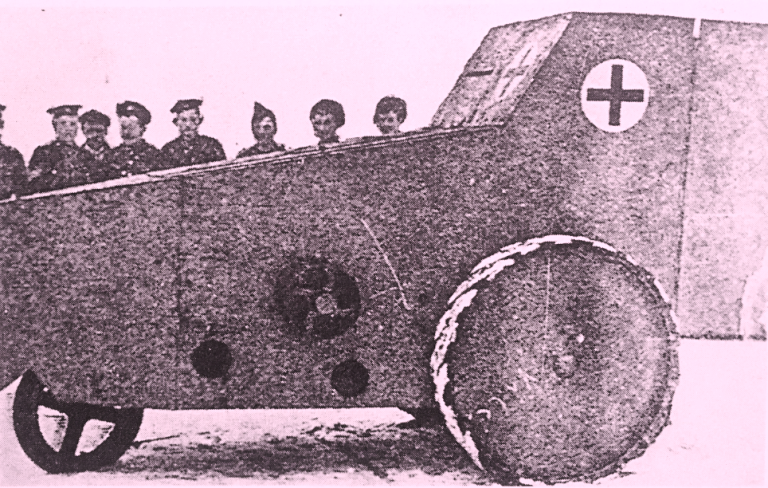
History The first armored ambulance for the battlefield began, like most armored vehicles of the early twentieth century, with the further development of the steam engine, and also, oddly enough, with the advent of the tractor.
Providing timely medical first aid on the battlefield means an increase in the wounded soldier's chances of survival and a substantial decrease in the severity of injury, the risk of serious complications, as well as a reduction in the time it takes for wounded soldiers to return to duty.
The most difficult thing in this situation is to provide assistance to the wounded directly on the battlefield, when bullets whistle and fragments fly around. At the same time, the one who provides assistance has every chance of being wounded himself. To solve this problem, at the very beginning of the twentieth century, a special machine was developed that could protect an orderly, a doctor and a wounded person during first aid directly on the battlefield.
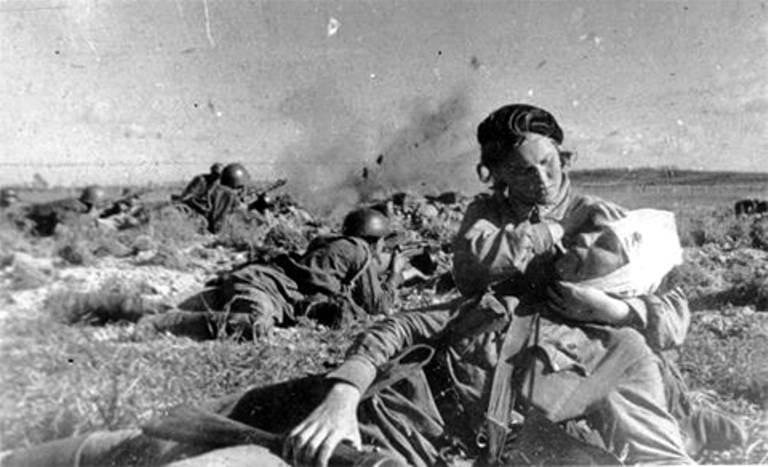
The Boer Wars taught the British army many lessons, which in most cases came at a cost. One of these lessons was that the military needed better and more efficient means of transporting and moving artillery off-road. The use of teams of animals such as oxen became more and more difficult in terms of efficiency.
A report to the army in 1902 indicated that the army needed new mechanized vehicles, although steam engines were still the mode of transport of choice. The preference for a pair, so to speak, ended in October 1903.
During this time, trials of the Hornsby tractor were completed with a new internal combustion petroleum engine designed by Herbert Ackroyd, which used crude oil as fuel. This tractor was built by Richard Hornsby & Sons. The firm received a prize of £ 1 for its invention and successful testing.
The Hornsby tractor, although very large, with a new engine and tracked chassis, marked the beginning of the use of internal combustion engines by the British Army. And already in the next 1904, the British army began to pay attention to tracked vehicles, which were still supposed to be used for transportation weapons and transportation of heavy artillery systems.
During this time, there was another car with an internal combustion engine, which received less attention. This is a lightweight Ivel tractor.
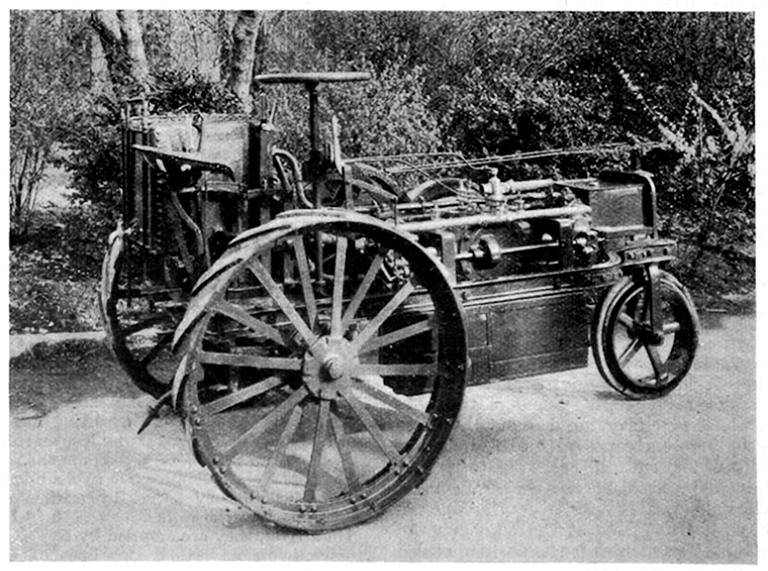
General view of the Ivel tractor, 1902

Sheet from patent US724513 for tractor Ivel dated September 13, 1903.
The Ivel farm tractor, created in 1902 by the pioneer of innovative tractors Mr. Daniel Albone (Elborn) in XNUMX, was a small unit. It was the first light combustion engine farm tractor built in the UK and made agricultural mechanization available to more farmers than the older steam engines.
In 1902, mechanization was still in its infancy, but the military was open to ideas. The small size of the light (just over a ton) Ivel motor tractor made it an attractive proposition for increasing the mobility of the British army in need of transporting supplies and light field guns.
This compact vehicle, launched by Ivel Agricultural Motors Limited, based in Biggleswaid, had a triangular arrangement of main wheels. At the rear, the tractor body rested on two large drive steel wheels 4 feet (1,2 m) in diameter, with steel spokes. These wheels provided tractor movement and traction. The front of the car rested on a smaller steel wheel with a solid rubber tire around its circumference, which was slightly narrower than the wheel.
The front wheel was used to steer the tractor and also to prevent the machine from sliding from side to side on the ground. A rubber tough tire on the steering wheel while driving on the road protected the steel wheel from the hard road surface and, again, aided steering.
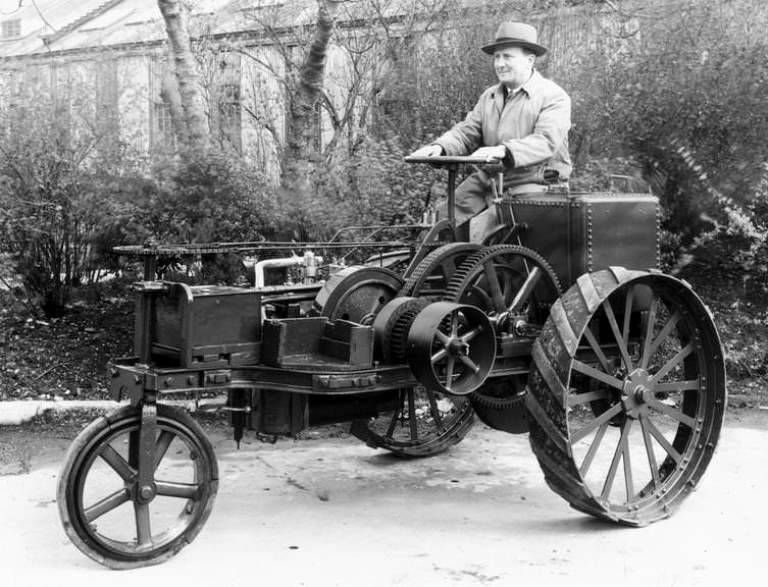
Constructor Daniel Albone is driving his brainchild
The steering wheel was simple in design and was located on a vertical steering column with its horizontal arrangement. The effort from the steering was transmitted to the front wheel using two push-pull cables (see photo above). In this case, the power steering was not provided. On the left side, in the middle part of the body, a belt-driven wheel was installed, which was used to drive various agricultural equipment.
It was also provided that when using the machine on roads or for additional traction on soft soils, additional rubber pads can cling to the large drive wheels outside in a circle.
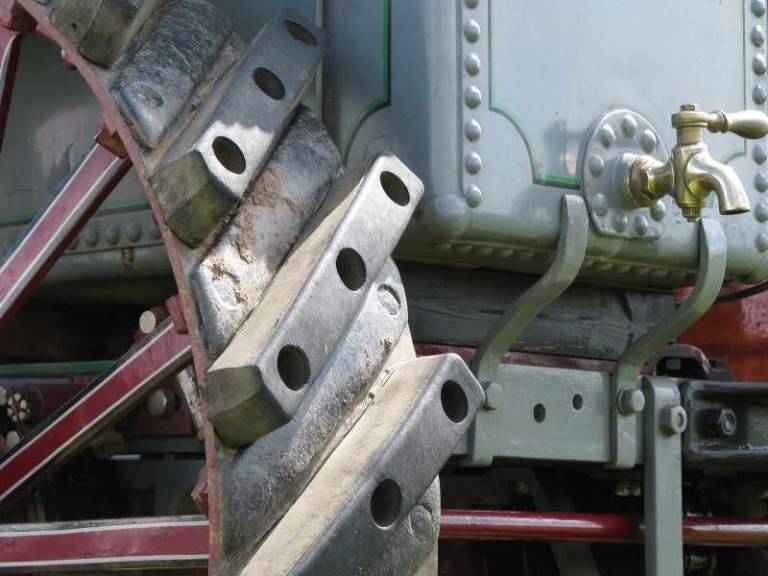
Large rubber pads mounted on a steel drive wheel
The driver's seat was located at the rear of the hull on the right side, next to the water tank for the engine cooling.
The power plant was a small 2-cylinder boxer gasoline engine with a capacity of 8 liters. with., which was located in the center of the tractor frame. From the very beginning of production of this conveyor in 1902, it has been used mainly by automobile engines from Payne and Baynes.
During operation, the engine power was constantly increased, bringing it to 1913 hp by 24. with. During tests in 1904, the engine power was 18 hp. with. At the same time, the designers assumed that the Payne and Baynes gasoline engine could be replaced by any other, especially when military orders came in.
Power from the engine was transmitted to the drive wheels via a simple two-speed gearbox with one forward and one reverse gear. This setup was ideal for a small machine specifically designed to pull plows, harrows and other agricultural equipment.
In total, the tractor weighed only 28 British quintals (1,42 tonnes) maximum, making it not only one of the smallest tractors, but also one of the first combustion engine tractors in the UK.
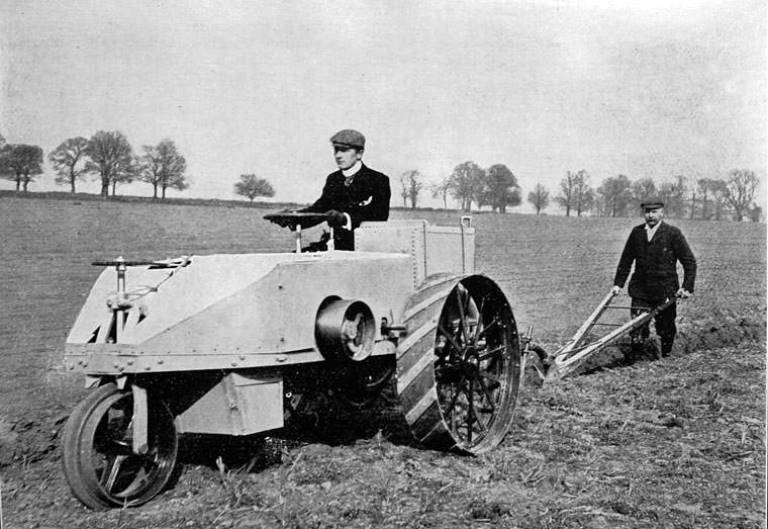
An Ivel steel-bodied tractor in operation pulls a plow, 1903
The development of the Ivel light tractor allowed Mr. Albone to get good orders for it not only in Great Britain, but also outside the British Empire.
Pay attention to this exhibit in Canada. At the suggestion of Major Palliser of the Canadian police, Daniel Albone began to develop a way to install armor on the structure of his tractor, and also began organizing the construction of an armored vehicle.
It should be noted that the armor for the new vehicle was developed by Major Palliser himself and manufactured by Cammell Laird and Company. At the same time, it should be noted that Palliser's idea involved the creation not of a combat vehicle as such, but the means to get to the wounded soldiers and provide them with first aid on the battlefield. It seems that when developing this vehicle, there were no ideas for evacuating or moving injured soldiers to safety. There was also no room for a stretcher in the car.
But the idea of an armored ambulance was an interesting novelty for the military.
Unlike many new ideas of the early twentieth century, which did not develop beyond a sketch on paper or even a drawing, this project was embodied in metal.
The Albone tractor received bulletproof armor, which was an armor plate with a thickness of 0,25 inches or 6,35 mm and which successfully protected the crew and wounded soldiers on the battlefield. The entire body of the tractor was covered with armor.
They also did not forget about the open drive wheels, which had metal spokes inside. The spokes were covered with a circle-shaped armor plate, which was fixed inside the wheel rim. The armor was in the form of a wedge, turning in front into an acute angle. To prevent the front steering wheel from rubbing against the armor walls during movement, two inverted V-shaped notches were made in them from below. The engine covered a large sloping bonnet, and two rectangular hatches provided service access. The entire skin structure was bolted to the frame.
The cockpit was square, with a frontal armor plate slightly tilted back. The frontal armor plate on the right side, where the driver was sitting, had a long horizontal viewing slot through which the driver could observe the road. At the same time, there were no slots for side viewing, which made it difficult for the driver not only to perform maneuvers, but also limited the flow of any information about what was happening outside.
At the rear of the cockpit were two large rectangular doors. Each of them was hinged and consisted of two parts. At the same time, each part had a smaller rectangular part, which was folded down, forming a kind of shield from the roof of the vehicle to ground level. Since both doors could be opened at the same time, a large bulletproof shield was formed - 2,13 m high and 2,74 m wide. Behind this shield, the medical team could provide assistance to the wounded, hiding from enemy fire.
With the installation of armor on the tractor, the weight of the vehicle increased from 1,42 tons to just over 1,52 tons.
Like the agricultural version of the tractor, its armored counterpart had only one seat on board - for the driver, who simultaneously served as a mechanic. Unfortunately, there was no room for a doctor or nurse. Therefore, the second member of the crew, when moving, had to squeeze between the door and the back wall of the water tank. There was also limited space for inventory or medical equipment.
However, despite all these shortcomings, this design still led to significant changes in military thinking.
The documents for a patent for a new armored vehicle were filed by Edward Palliser at the end of 1903. In this documentation, Palliser explained the possible uses of the machine, including as a tractor for the transport of ammunition.
However, most of the military did not accept the option of using the car as a tractor, especially after they were shown how the folding rear shields were to be used as protection of the wounded from enemy fire.
At the same time, Palliser made another comment regarding the developed vehicle used as an ambulance. He explained that the rear doors, if necessary, can be removed in order to use them as a shield, independent of the vehicle. This feature was designed specifically for the Royal Army Medical Corps (RAMC), Palliser said.
In the early spring of 1904, Polliser was granted a patent for this development, which was named Ivel Motor Ambulance.

A sheet from the British Patent GB10082 1903. On the left, the location of the armor plates on the tractor is shown, on the right is a front view with the flaps open
The car entered its first test on May 17, 1904. It took place in Beasley (Surrey) at the home of the National Rifle Center.
During the first test, the car did not have any markings that would refer it to medical transporters. Here Mr. Albone showed not one, but two of his cars. Both were his light tractors, but only one was armored.
Ivel was looking for a military contract, and now it has the opportunity to demonstrate the versatility of its design by presenting an armored version of the tractor. Cammell's first armored vehicle was shown as an ambulance. It was also stated that it can be used as a tractor.
This sample performed much better against the background of a somewhat ridiculous demonstration of a second unarmored vehicle, when its belt drive was used to support the operation of the light generator.
The armored tractor has also been shown to be capable of transporting medical vans or a casualty van holding up to 30 people. He could pull them off-road as well as handle uneven terrain with confidence, reaching speeds of 3 to 6 mph.

Artistic view of the Ivel armored vehicle. Drawing from the site aviarmor.net


An Ivel First-Aid armored vehicle during trials at Beasley on May 17, 1904. Photo from Motor-Car Journal and Scientific American
At the next stage, at which there were military leaders and a representative of the US Embassy in London among those present, the car drove through the test site, after which "They fired at him with rifles at ranges from 20 to 100 yards, but without piercing the armor.".
Thus, without damage from rifle fire and retaining mobility, the armored tractor has established itself as a reliable machine.
Several small problems were noted, but overall the test was successful. The car has shown its potential as an ambulance, and with a belt drive on the side, and the ability to support a field hospital with light and water. After a couple of months, it was decided to hold the next demonstration.
The second official display of the Ivel ambulance took place at Bisley Barracks in mid-November 1904, under the watchful eye of Sir W. Taylor of the Military Medical Service. Here again, it was noted that the car moves easily off-road. She was again tested with rifle shooting, and again it turned out that the protection was impenetrable.
The only significant change to the car after the tests in May was that in the second test, large red crosses were drawn on it in a white circle. One cross was located on the front panel next to the driver's viewing slot, one on the side walls of the cab and one more on each extreme (outer when opening) half of the rear door section.
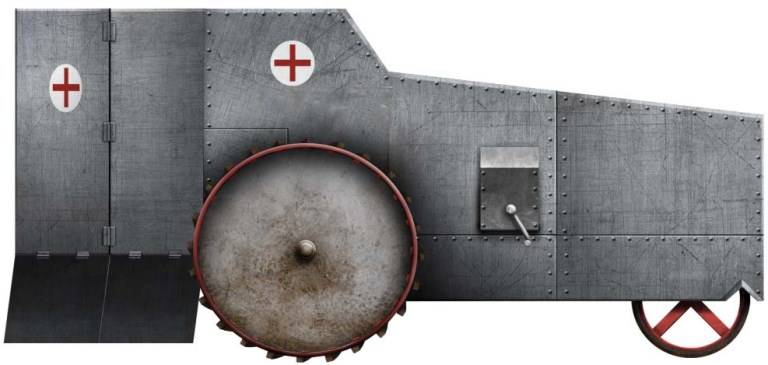
Illustration of an Ivel Motor or Ivel First Aid Motor ambulance with the rear panels open. Drawing by Juvnashva Sharma


Ivel Motor Ambulance tested in November 1904. Photo from Scientific American and Automotor Journal
Despite these tests and the obvious practical benefits of the design, no orders were received for it.
The year was 1905, the Boer War was over, and the First World War had not yet begun. And, since major wars were not yet foreseen in the foreseeable future, there was no need in the Ministry of War for urgent adoption of machines of this class.
This intransigence was challenged in March 1905 in the House of Commons by Colonel Calmont, MP for the East Antrim Conservative branch, who wanted to know if the War Office would cover the costs of testing an ambulance. All he requested was a formal field test of the vehicle, paid for by the War Department. Such a test would hardly have become onerous for the military, given that the car had already been built with funds from the Ivel company.
However, Arnold-Foster (Secretary of State for War) responded that the ambulance was considered but was rejected because it did not meet the requirements of the service. Therefore, further testing was not considered.

Ivel motorized ambulance with open rear doors in front of a line of soldiers
Despite the fact that the army was unable to adopt the Ivel Motor Ambulance, the firm still succeeded in international export, but of tractors. However, Daniel Albone died in 1906 at the age of 46. Without this man's insight and imagination, the firm entered a period of decline.
In 1915, immediately after the outbreak of the First World War, the company was liquidated, just when an armored ambulance could play a significant role in rescuing the wounded on the battlefield.
The fate of the Ivel ambulance is unclear.
After trials in 1904 and the official refusal of any further work on it in 1905, the car was most likely converted back into a conventional tractor, which was sold.
Today it is known that there are only seven Ivel tractors left in the world, and an ambulance (even in the form of a replica) is not included in their number.
Despite the fact that the armored ambulance was not accepted into service, the idea of creating vehicles of this class was not abandoned.
In 1938–1939, an experienced ambulance transport armored vehicle BA-22 was developed and produced in the USSR. The car had 6-mm bulletproof armor and could carry up to 4 recumbent wounded soldiers or up to 10-12 seated lightly wounded soldiers. But after the tests, the vehicle was not accepted for service.
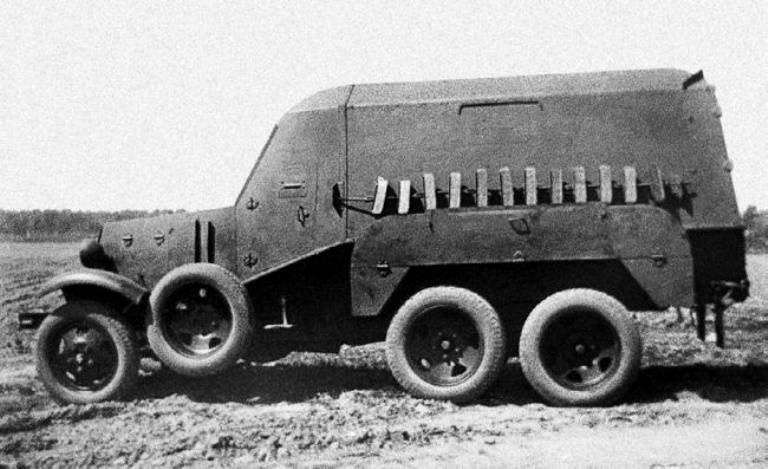
Soviet ambulance armored car BA-22, 1939
During World War II, the German and American armies were more fortunate in this regard.
Since 1942, the Germans have used the Sd.Kfz.251 armored personnel carrier (in its medical version Sd.Kfz.251 / 8), which could provide assistance to up to 8 wounded soldiers. Inside the car, two lying wounded or up to 8 lightly wounded soldiers could be accommodated.
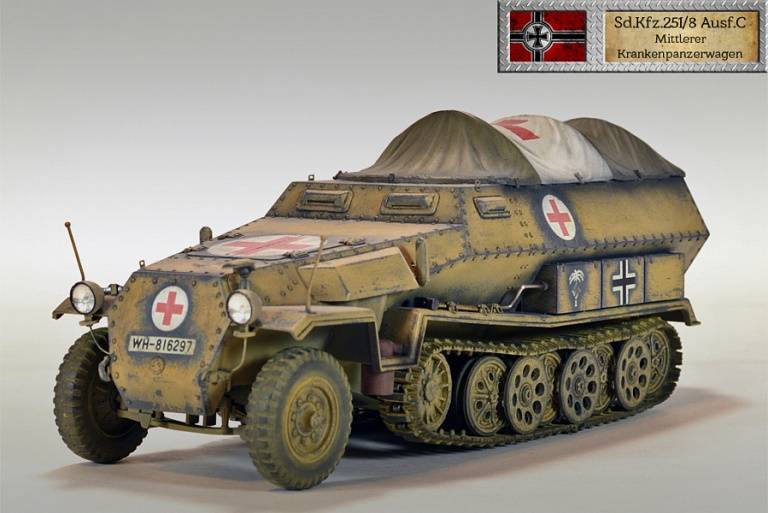
Medical version of the Sd.Kfz.251 armored personnel carrier
Since the summer of 1942, the American army has used an armored ambulance developed on the chassis of the M3 half-track transporter with some success. According to its characteristics, it was equal to the German one.
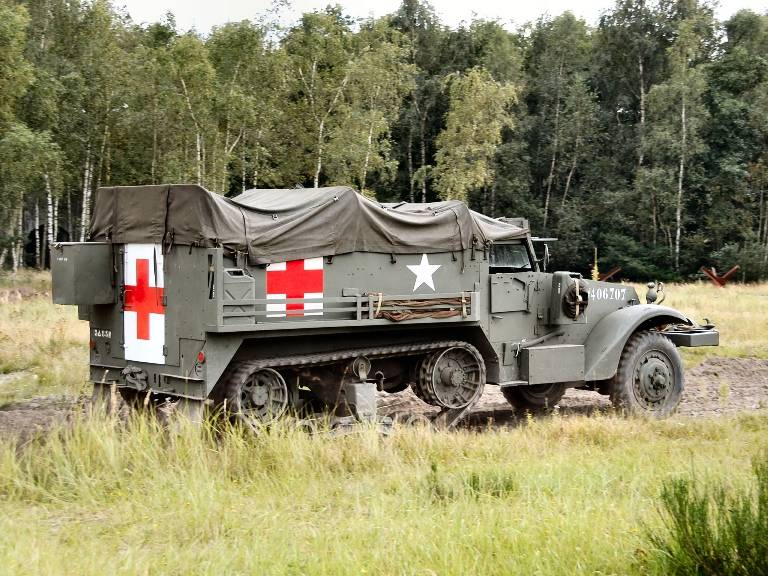
American medical armored personnel carrier
However, these two medical transporters, unlike the Soviet prototype, did not have an armored roof, which reduced the chances of safely transporting the wounded from the battlefield to the rear.
After the end of World War II, they began to work more closely on the development of vehicles of this class.
Characteristics of the Ivel armored tractor:
Overall dimensions: height 2,13 m
Weight: 1,52 tons with armor
Crew: 1 (driver / commander) + 1 medic
Engine: Payne and Baynes 2-cylinder petrol engine with 18 HP with.
Road speed: 4,8-9,7 km / h
Armor: Cammell Bulletproof Plate (6,35mm)
Total produced: 1 pc.
Information